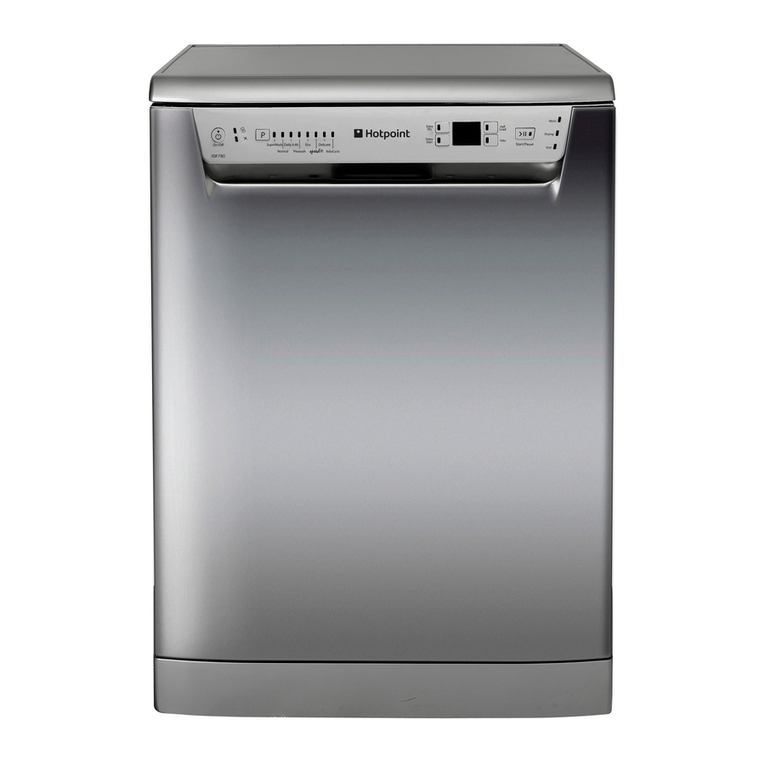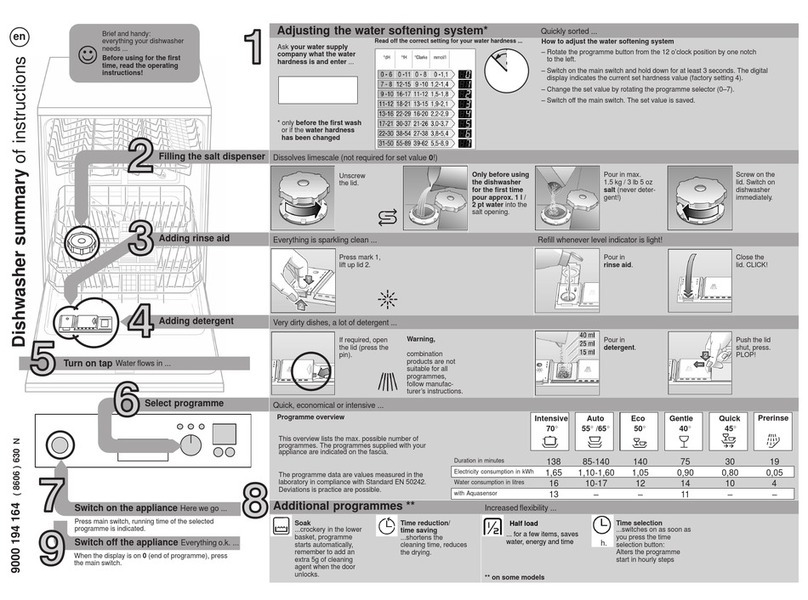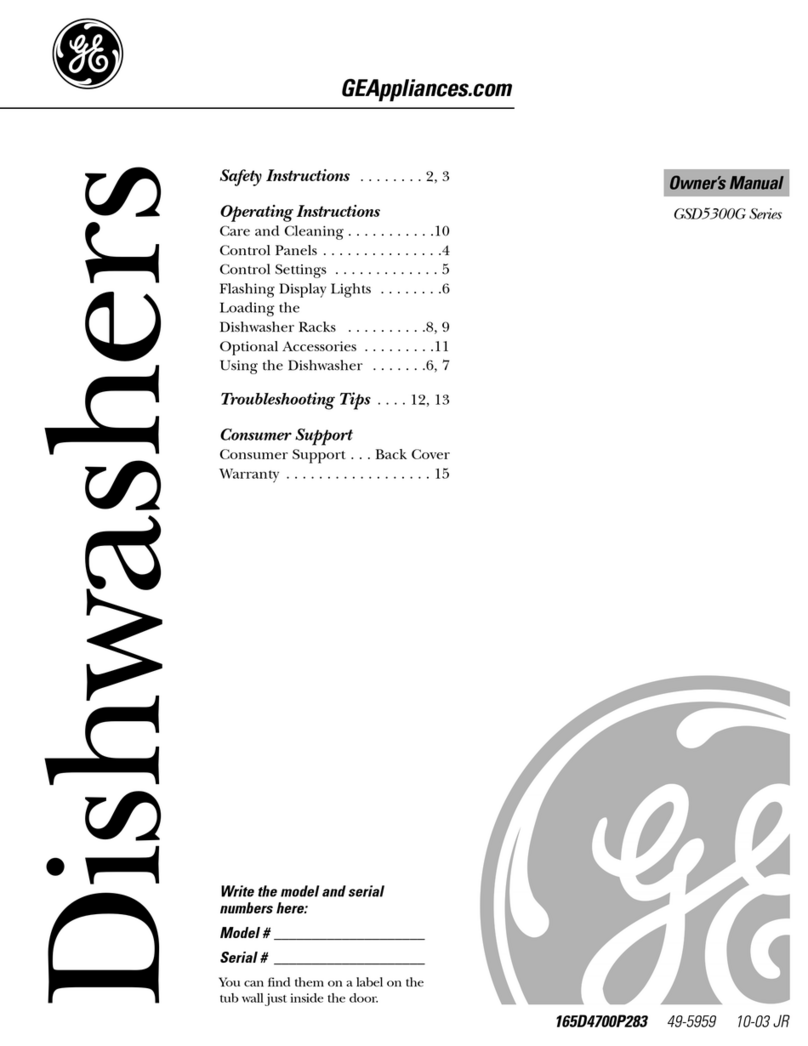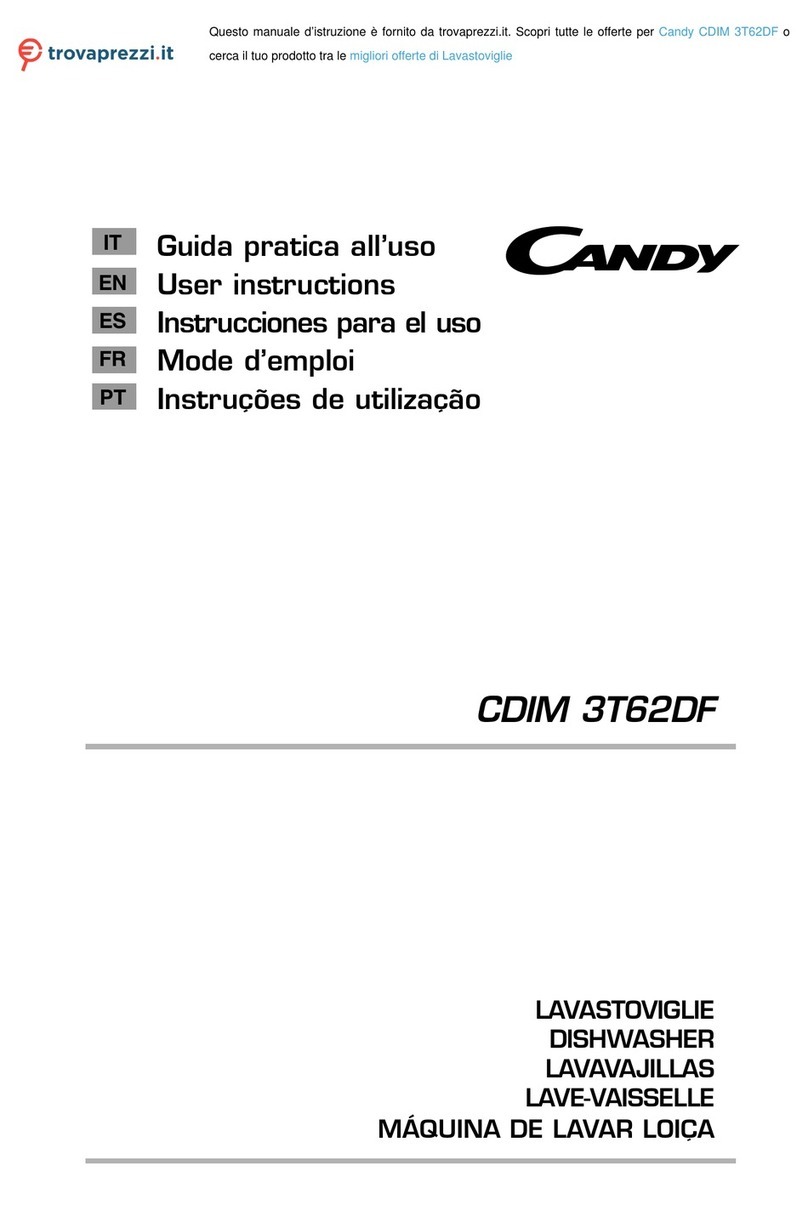PRODIS T1215BT User manual

INSTRUCTION MANUAL FOR DISHWASHERS
Page 1 of 12
UK
TRANSLATION FROM THE ORIGINAL INSTRUCTIONS
CONTENTS
CHAP 1 PREFACE ...................................................................................................................2
CHAP 2 INSTALLATION ..........................................................................................................2
2.1 UNPACKING ......................................................................................................................2
2.2 POSITIONING.....................................................................................................................3
2.3 ELECTRICAL CONNECTION..................................................................................................3
2.4 WATER CIRCUIT HOOKUP ...................................................................................................4
2.5 CONNECTION TO THE DRAIN LINE........................................................................................4
2.6 RINSE AID AND DETERGENT................................................................................................4
CHAP 3 RISKS AND IMPORTANT WARNINGS ......................................................................5
3.1 NORMAL OPERATING CONDITIONS ......................................................................................5
CHAP 4 USING THE MACHINE................................................................................................6
4.1 KEY AND SYMBOLS ............................................................................................................6
4.2 SWITCHING THE DISHWASHER ON.......................................................................................6
4.3 FILLING THE RACK .............................................................................................................6
4.4 CYCLE SELECTION AND START-UP ......................................................................................7
4.4.1 Under-counter dishwashers...............................................................................7
4.4.2 Hood dishwashers .............................................................................................7
4.5 CONTINUOUS WASHING (*OPTIONAL) ..................................................................................7
4.6 REMOVING THE INTEGRAL FILTER .......................................................................................7
4.7 EMPTYING THE DISHWASHER..............................................................................................7
4.7.1 Appliances with no drain pump..........................................................................7
4.7.2 Appliances with drain cycle (*optional)...............................................................7
4.8 TURNING THE DISHWASHER OFF.........................................................................................8
4.9 RESIN REGENERATION (*OPTIONAL)....................................................................................8
4.10 DISPLAYING INFORMATION.................................................................................................8
4.11 LIST OF VIEWABLE MESSAGES ............................................................................................8
4.12 END OF SHIFT....................................................................................................................8
CHAP 5 MAINTENANCE..........................................................................................................9
5.1 GENERAL RULES ...............................................................................................................9
5.2 CLEANING.........................................................................................................................9
5.3 CLEANING THE FILTER UNIT................................................................................................9
5.4 CLEANING THE ARMS.........................................................................................................9
CHAP 6 SELF DIAGNOSTICS................................................................................................10
CHAP 7 SETTINGS.................................................................................................................11
7.1 NUMBER OF CYCLES TO REGENERATE RESINS...................................................................12
CHAP 8 SCRAPPING .............................................................................................................12
CHAP 9 ENVIRONMENT........................................................................................................12
In legal terms, the manufacturer reserves the property of this document. It is forbidden to reproduce it or divulge it with any means
without prior written authorisation.
The manufacturer reserves the right to introduce changes in order to achieve the improvements it deems necessary without prior notice.
442439 D REV02 05-12-2014 U UK

INSTRUCTION MANUAL FOR DISHWASHERS
Page 2 of 12
UK
Chap 1 PREFACE
This manual contains important safety warnings relating to installation, use and
maintenance.
Failure to observe the instructions in the enclosed documentation may compromise
the safety of the appliance and immediately voids the warranty.
Warnings:
Ke
ep all documentation in the vicinity of the appliance; make it available to the technicians and
operators charged with operating it and
keep it in good condition in a safe place, along with
extra copies for frequent reference
The operator must read, unders
tand and familiarise himself with the contents of this
manual before working on or with the appliance.
The appliance is intended solely for professional heavy duty dishwashing applications and must
be installed, operated and serviced only by qualified pers
ons according to the manufacturer's
instructions.
Warranty:
The manufacturer is not liable for any damage or injury resulting from failure to observe the
instructions or improper use of the machine
Failure to observe the instructions in the enclosed do
cumentation may compromise the safety of
the appliance and immediately voids the warranty
Installation and repair by unauthorised technicians and the use non-
original spare parts
immediately void the warranty.
Storage:
Transport and storage: -10°C to 55°C with peaks up to 70°C (for no longer than 24 hours)
Chap 2 INSTALLATION
Proper installation is essential to the good operation of the appliance. Some of the data required for
installation of the appliance are given on the nameplate on its RH body panel, and
a copy is included
on the cover page of this manual.
The appliance may only be installed by qualified persons authorised to do so.
For Australia and New Zealand this machine must be installed in accordance with
AS/NZS3500.1
2.1 Unpacking
Check the condition of the packaging, and note any evident damage on the shipping bill. Remove the
packaging and check that the appliance is in good condition; immediately report any damage to the
reseller and the shipping agent by fax or registe
red letter with return receipt. If the damage is such as to
compromise the safety of the appliance, do not install or operate it until it has been inspected by a
qualified technician.
The packaging (plastic bags, expanded polystyrene, nails, etc. ) are hazardous and
must not be left within the reach of children or pets.

INSTRUCTION MANUAL FOR DISHWASHERS
Page 3 of 12
UK
2.2 Positioning
•
Check that there are no objects or materials in the installation area which may
be damaged by the steam emitted by the a
ppliance during operation, or if there
are, make sure they are properly protected.
•
Before positioning the appliance, set up the electrical power supply, water
supply and drain connections
•The floor or build-in unit must be rated to support the weight of the appliance
•To ensure that it is stable, level the appliance with its four feet.
•
The appliance is intended for fixed installation only; any other approaches must
be agreed with and approved by the manufacturer.
•Remove the protective film from its body pane
ls before operating the
dishwasher.
2.3 Electrical connection
•
The power supply must be fitted with a omnipolar circuit breaker (master power
switch) to break all contacts including neutral, with a contact gap of at least 3
mm and
thermal cutout or fuses, which must be set or rated to the power
indicated on the machine's nameplate.
•The master power switch
must be fitted to the power line in the vicinity of the
installation and may be connected to only one machine at a time.
•The mains voltage and frequency must match the nameplate ratings.
•
The installation must include a grounding system conforming with established
electrical safety legislation, to protect the operator and the appliance itself
•The power line, which must be H07RN-F unit, must not be stretched or crushed during normal
operation or maintenance.
•
The appliance must also be connected to an equipotential system with the screw marked with the
symbol.
•The equipotential cable must have a cross section of 10 mm².
•Respect the polarities indicated in the wiring diagram.
•For further information, refer to the wiring diagram.
Do not use multi-sockets, adapters, cables of an inadequate cross section or type or
with extensions not conforming to established electrical installation regulations.

INSTRUCTION MANUAL FOR DISHWASHERS
Page 4 of 12
UK
2.4 Water circuit hookup
The appliance must be connected to its water supply with a flexible hose. A
shut off valve (cock) must be installed between the water supply line and
the appliance's solenoid valve. The cock must be close to the appliance.
•The water supply, temperature and pressure must be compatible with the ratings on the
machine's nameplate.
•If the hardness of the water is greater than 14 F (8 dH), we recommend using an internal
water
softener (available on request
). If the hardness of the water is greater than 35 F (19.5 dH), install
and external water softener upline of the solenoid valve.
•If the water has a very high residual concentration of high conductivity minerals, we reco
mmend
installing a demineralisation system.
Free drain
2.5 Connection to the drain line
•
The drain line must consist of a free drain sump with siphon suited to
the flow capacity of the drain hose supplied with the appliance. The
h
ose must be able to reach the sump without stretching, restriction,
folding, crushing, pressing or forcing in any way.
•
The tub drains under gravity, so the drain sump must be lower than the
machine's base.
Max.
1 m
With pump (available on request)
•
if the drain is not lower than the base of the appliance, you can use the
version with drain pump (available on request).
•In this case, the drain connection may be no higher than 1 m.
•Always check that the drain works properly and is not blocked.
•Any other solution must be approved by the manufacturer in advance.
2.6 Rinse aid and detergent
•
The rinse aid and detergent are dispensed by the machine's integral dispenser (depending on
model).
•The dose is set by the installer in relation to the hardnes
s of the water, and he also calibrates the
dispensers themselves.
•Before calibrating them, fill the dispenser supply tubes with their respective product.
•The units are calibrated with the adjuster screws, or directly with the control panel (as applicable).
•
The level of fluid in the container must be sufficient for priming; do not allow it to drain completely
or top it up with corrosive or impure product.
NEVER use CHLORINE or HYPOCHLORITE based detergents.
We recommend installing an automatic detergent dispenser.

INSTRUCTION MANUAL FOR DISHWASHERS
Page 5 of 12
UK
Chap 3 RISKS AND IMPORTANT WARNINGS
•This appliance is intended solely for the use for which has been designed. Any other use is
improper and hazardous.
•The specialised technician responsible for installing the appliance must instruct the user on it
s
operation and any attendant safety measures, including practical demonstrations.
•
Only the manufacturer or an authorised service centre with qualified staff may work on the
machine, even in case of malfunction, using only original spare parts.
•Always disc
onnect or isolate the machine from its power and water supplies before servicing,
repairing or cleaning it.
•The machine may NOT be used by persons untrained in its use.
•The machine may NOT be left powered up when not in use.
•NEVER open the machine quickly if it has not completed its cycle.
•NEVER use the machine with its guards removed.
•NEVER
use the machine to wash objects of any form, size or material not guaranteed to be
machine-washable or not in good condition.
•NEVER use the machine or any of its assem
blies as steps or support for persons, property or
animals.
•NEVER overload the open door of front-
loading machines, which is rated only to support the
basket loaded with dishes.
•NEVER place your bare hands in the wash solution.
•NEVER overturn the machine after it has been installed.
•
If you notice any malfunction or fluid leak, immediately disconnect the power supply and shut off
the water supply.
•Do not install the dishwasher in the vicinity of heat sources over 50°C.
•NEVER leave the dishwasher exposed to the weather (rain, direct sunlight, etc.)
•The dishwasher may not be installed outdoors without proper cover.
•Never start a wash programme without the overflow in the tub (as applicable).
•Never place magnetic objects in the vicinity of the machine.
•Do not use the top of the machine as a table or support.
•The installer is responsible for checking that the grounding system is fully operational.
•
At the end of testing, the installer must issue a written declaration stating that the machine has
been installed and tested in accordance with established legislation and good practice.
•DO NOT change the position or
tamper with the elements that compose the machine, these
operations could compromise its safety.
•Weighted sound pressure level LpA ≤ 70 dB(A).
3.1 Normal operating conditions
Ambient temperature: 40°Cmax /4°Cmin (average 30°C)
Altitude : up to 2000 metres
Relative humidity : Max 30% at 40°C / max 90% at 20°C

INSTRUCTION MANUAL FOR DISHWASHERS
Page 6 of 12
UK
Chap 4 USING THE MACHINE
4.1
Key and symbols
Referring to Fig.1:
1
ON/OFF LED AND BUTTON
4b
RINSE TEMPERATURE DISPLAY
2
PROGRAMME SELECTION BUTTON
5
CYCLE LED
3
START BUTTON
6
STATE LED
4
AUTOMATIC START BUTTON
7
AUTOMATIC START LED (hood only)
4a
WASHING TEMPERATUREDISPLAY
Short washes
Drain cycle
Medium wash
Resin regeneration
Long wash Continuous wash
4.2 Switching the dishwasher on
Referring to Fig.2
•Turn on the main power switch and open the external water tap.
•Check the presence of the overflow.
•Press ON/OFF (1).
•In the versions with incorporated water softener (*optional) to start loading press START (3), if
there is no water softener the loading starts automatically when the dishwasher is switched on.
•The STATE LED (6) flashes red until the level is reached.
•When the tub level is reached the STATE LED (6) switches off.
•The green dot in the corner of the TEMPERATURE DISPLAY (4a - 4b) indicates that the washing
nor rinsing water is heating..
•When the working temperature is reached, the STATE LED (6) stays on, green.
•The optimal wash conditions have been reached.
4.3
Filling the rack
Referring to
Fig. 3
,
to ensure the correct operation of the dishwasher follow the rules described below:
•Use a suitable rack, fill without overloading and without overlapping the dishes.
•Always wipe the dishes before placing in the dishwasher; do not put dishes with dry or solid
residues in the washer.
•Place the empty dishes in the rack facing downwards.
•Place plates and the like in the sloping rack, with the inner surface facing upwards.
•Place the cutlery in the cutlery basket, handle end down.
•Do not place silver and stainless steel cutlery in the same cutlery basket as this will turn the silver
brown and may corrode the steel.
•Wash the dishes immediately after use, in order to prevent any residue from hardening and sticking
on them.
•Use only solid, dishwasher-proof dishes.

INSTRUCTION MANUAL FOR DISHWASHERS
Page 7 of 12
UK
4.4
Cycle selection and start-up
4.4.1 Under-counter dishwashers
•Press the PROGRAMME SELECTION (2)
button repeatedly to select a wash cycle that is suitable
for the dishes to be washed; the cycle LED lights up to indicate the cycle chosen (Fig. 4).
•To run the programme, press START (3); the CYCLE LED (5)
corresponding to the chosen wash
cycle starts to flash.
•When the cycle is completed, it stays on, fixed.
•For rapid drying, remove the rack from the machine as soon as the cycle finishes.
•To stop a wash cycle early, press the START button (3).
4.4.2 Hood dishwashers
•Press the PROGRAMME SELECTION (2)
button repeatedly to select a wash cycle that is suitable
for the dishes to be washed; the cycle LED lights up to indicate the cycle chosen (Fig. 4).
•Press AUTOMATIC START button (4), the AUTOMATIC START LED (7) lights up
Use the START button (3) if there is no button 4.
•Lower the hood; the cycle starts automatically and the CYCLE LED (5)
corresponding to the
chosen wash cycle starts to flash.
•When the cycle is completed, it stays on, fixed.
•For rapid drying, remove the rack from the machine as soon as the cycle finishes.
•To stop a wash cycle early, press the START button (3).
4.5
Continuous washing (*optional)
•This is an extended cycle; the time varies according to the model.
•The cycle duration may be varied as required by pressing START (3)
during the wash cycle, to
interrupt the wash and start the rinse phase.
4.6 Removing the integral filter
•Move the washing and rinsing arms at right angles to the edge of the door (Fig.7).
•Lift each semi-filter by the relative handle.
4.7 Emptying the dishwasher
4.7.1 Appliances with no drain pump
•Switch the dishwasher off.
•Remove the integral filter if present (Fig.7 A).
•Pull the overflow upwards (Fig.8 B), and wait for the tub to drain completely.
•If necessary, extract the tub filter and clean (Fig. 8 C).
4.7.2 Appliances with drain cycle (*optional)
•Select the drain cycle using the PROGRAMME SELECTION button (2).
•If present, remove the integral filter (Fig.7 A).
•Pull up and remove the overflow (Fig. 9).
•Close the door/hood.
•Press START (3) to run the cycle.
•The machine runs a drain cycle with self-cleaning (*optional) and then switches off.
•If necessary, extract the tub filter and clean (Fig. 8 C).

INSTRUCTION MANUAL FOR DISHWASHERS
Page 8 of 12
UK
4.8 Turning the dishwasher off
•Press ON/OFF (1), on the DISPLAY (4)
the central segments will light up, indicating that the
machine is powered.
4.9
Resin regeneration (*optional)
On machines with an internal softener, when the regeneration cycle led lights up red (Fig. 11
) you need
to run a regeneration cycle to restore proper function of the internal softener. Proceed as follows:
•Empty and clean the dishwasher.
•Remove the integral filter and open the salt container in the tub.
•Pour in 250-300g of regeneration salt (1or 2mm grain size kitchen salt with no additives).
•Close the container firmly.
•Make sure the overflow has been removed
•Close the door and switch the dishwasher on.
•Press the PROGRAMME SELECTION button (2) to select the regeneration cycle.
•Press the START button (3) to start a cycle.
•The regeneration cycle lasts around 20 minutes.
•The dishwasher will switch off when the cycle has completed.
N.B. Do not switch off the machine if a regeneration cycle is underway
4.10 Displaying information
With the machine on, hold the PROGRAMME SELECTION button (2) down for five seconds until “CC
”
appears, followed by the number of wash cycles carried out during the machine life.
4.11 List of viewable messages
Door open
Number of cycles carried out
4.12 End of shift
•At the end of the day always drain the machine as described in the section Machine draining.
•Disconnect the power supply by means of the main switch and close the external water cock.
•Perform routine maintenance and clean the machine as described in the section Maintenance.
•If possible, leave the door ajar to prevent bad odours building up inside the machine.

INSTRUCTION MANUAL FOR DISHWASHERS
Page 9 of 12
UK
Chap 5 MAINTENANCE
5.1
General rules
Before doing any maintenance, completely drain out all water, shut off the power
supply and close the water supply cock.
Do not use water under pressure - it can damage the electrical equipment.
Only wash the body panelling when it is cold, using only product specifically designed for steel.
If there is a risk of ice forming, drain the water from the boiler and wash pump.
5.2 Cleaning
To keep the machine in good working order, it must be maintained regularly as explained below. We
recommend periodically running a sanitising treatment with suitable non-
corrosive commercial
products.
5.3 Cleaning the filter unit
Run this procedure at the end of the day or when you see the filters are dirty:
1. Remove and clean the baskets.
2. Empty out the tub as explained in “Machine draining”.
3. Remove and carefully clean all the filters.
4. Do not use abrasive products to clean the tub.
5. Restore all removed parts when finished.
5.4 Cleaning the arms
The wash and rinse arms are easily removed in order to clean their nozzles and prevent
blockage/encrustations.
Proceed as follows ( Fig.10
):
•Undo nut R and remove the arms.
•Wash all parts under a jet of running water and clean the nozzles thoroughly, using a toothpick or
pointed tool if necessary.
•Clean the arm rotation pins inside the machine and the wash and rinse water drainage area.
•Restore the arms and check that they rotate freely.

INSTRUCTION MANUAL FOR DISHWASHERS
Page 10 of 12
UK
Chap 6 SELF DIAGNOSTICS
The machine is equipped with a self-
diagnosis system that registers and warns of a number of
malfunctions.
Fault
Description and possible remedies
No rinsing. The rinsing cycle was not completed correctly. Make sure that the rinsing
nozzles are clean.
No drainage. The water was not drained or drained incorrectly. Check that the drain
pipe is not bent or crushed and that the siphon and filters are not blocked. In machines
fitted with an overflow pipe, remove this before starting the drainage cycle.
Rinsing temperature reset fault. The boiler temperature did not reset in the set time
during the washing cycle. Switch the machine off and then on and run a new cycle.
SAFE
Water filling in tank fault. Make sure the pipes are connected correctly, and that the
water tap is open. Where foreseen, check the presence of the overflow. Switch the
dishwasher off and then on and fill again.
Tank thermometer fault. (Probe open) The machine does not read the tank
temperature value. Switch the dishwasher off and then on.
Tank thermometer fault. (Probe short circuited) The machine does not read the
tank temperature value. Switch the dishwasher off and then on.
Boiler thermometer fault. (Probe open) The machine does not read the boiler
temperature value. Switch the dishwasher off and then on.
Boiler thermometer fault. (Probe short circuited) The machine does not read the
boiler temperature value. Switch the dishwasher off and then on.
Boiler loading time out: boiler not filled. Impossible to carry out rinse cycle. Check
that the water tap is open. Switch the dishwasher off and then on and run a new cycle.
Tank temperature reset fault: The tank temperature did not reset in the set time
during the washing cycle. Switch the machine off and then on and run a new cycle.
SAFE
Electro-mechanical safety device: the boiler or tub safety thermostats have cut in, or
the tub safety pressure switch has been triggered.
SAFE
Level safety switch: Incorrect water level in the tank.
WARNING! Switching the dishwasher off and then on again "resets" the signals, if after carrying
out the instructions given the problem persists, contact an Authorised Service Centre.

INSTRUCTION MANUAL FOR DISHWASHERS
Page 11 of 12
UK
Chap 7
SETTINGS
The following settings should only be configured by a qualified technician.
The parameters listed below can be set during installation of afterwards, accessing the settings menu as
follows:
•Machine in standby with door open.
•Press buttons 2 and 3 together (cycle selection and START) for 5 seconds and enter the key
CH 12
(buttons 2 and 3 to change the parameter, 1 to confirm).
•Then press button 1 (ON/OFF) repeatedly to scroll through the following headings, enabling and
/or
changing them using buttons 2 and 3 (the modified parameter is memorised without being
confirmed). The list of parameters may vary according to the type of dishwasher.
Language
Language selection
Boiler
Temperature
Boiler temperature settings for programmes. In the versions with
atmospheric boiler (rinse pump) there are different settings for each
programme (b1 – b2 – b3)
Tank
Temperature
Tub temperature regulation for programmes. Rinse pump versions have
different settings for each programme (t1 – t2 – t3)
Thermo - Stop
Enabling the Thermostop function, which guarantees the correct
rinse temperature.
Energy
Saving
Enabling the Energy Saving function, which guarantees
energy savings when the dishwasher is on but not in use.
Detergent
Pump
Manual operation of detergent doser
Rinse Aid
Pump
Manual operation of rinse aid doser
Manual
Rinse
Manual operation of the rinse pump
Dosage
Detergent
Detergent dosing time
Dosage
Rinse Aid
Rinse aid dosing time
Water
Hardness
Setting the supply water hardness (dishwashers with water softener): enter
the values given in the table below
Set Number
Service Cycles
Setting and enabling the cycle counter to enable the servicing warning
Autostart
Autoenabling
Automatic enabling of automatic starting
Cycle Counter Cycle counter
Once all necessary parameters have been set, to exit and memorise any changes simply press and
hold button 1 for a few seconds until the on-line dashes appear.

INSTRUCTION MANUAL FOR DISHWASHERS
Page 12 of 12
UK
7.1
Number of cycles to regenerate resins
The nu
mber of cycles between one resin regeneration and the next depends on the hardness of the
local water, and should be set in accordance with the table shown. Set the parameter dH
in the settings
menu as described in the paragraph:
dH °F
No.
Cycles
dH °F
No.
Cycles
dH °F
No.
Cycles
dH °F
No.
Cycles
6
10
160
10
18
120
14
25
80
18
32
40
7
12
150
11
20
110
15
27
70
19
34
30
8
14
140
12
21
100
16
29
60
9
16
130
13
23
90
17
30
50
N.B. each unit on the display corresponds to 10 cycles.
Chap 8 SCRAPPING
Our machines do not contain materials requiring special handling.
(Applicable in the EU and countries with sorted waste disposal)
The mark applied to the product or its documentation indicates that it must not be
scrapped with domestic waste
when it reaches the end of its service life. To prevent
damage to the environment or health risks due to improper scrapping, keep this product
separate from other waste and recycle it so as to promote sustainable use of materials.
Domestic users are requ
ested to contact their reseller or local authority for information on sorted waste
disposal and recycling for this type of product.
Corporate users are requested to contact their supplier and check the terms and conditions of the
purchase contract.
The product may not be scrapped together with other commercial waste.
Chap 9 ENVIRONMENT
RESPECT FOR THE ENVIRONMENT
Proper use of the dishwasher can improve its environmental footprint, if the following simple rules are
observed:
Only wash full baskets.
Switch the dishwasher off when not using it.
Keep the machine closed when it is in standby.
Use wash programmes suited to the amount of soiling.
Supply the machine with hot water, if gas heated.
Make sure the drains flow into a suitable sewer.
Do not exceed the recommended dose of detergent.
The manufacturer reserves the right to modify the electrical, technical and aesthetic features of this
appliance and replace any of its parts without notice, as he deems necessary to offer a reliable
product with a long service life and advanced technology.
This manual suits for next models
1
Table of contents
Popular Dishwasher manuals by other brands

Smeg
Smeg DWAFI4510 instruction manual
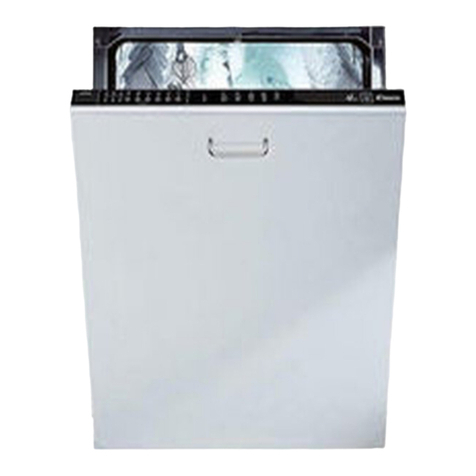
Candy
Candy CDI 2012 User instructions
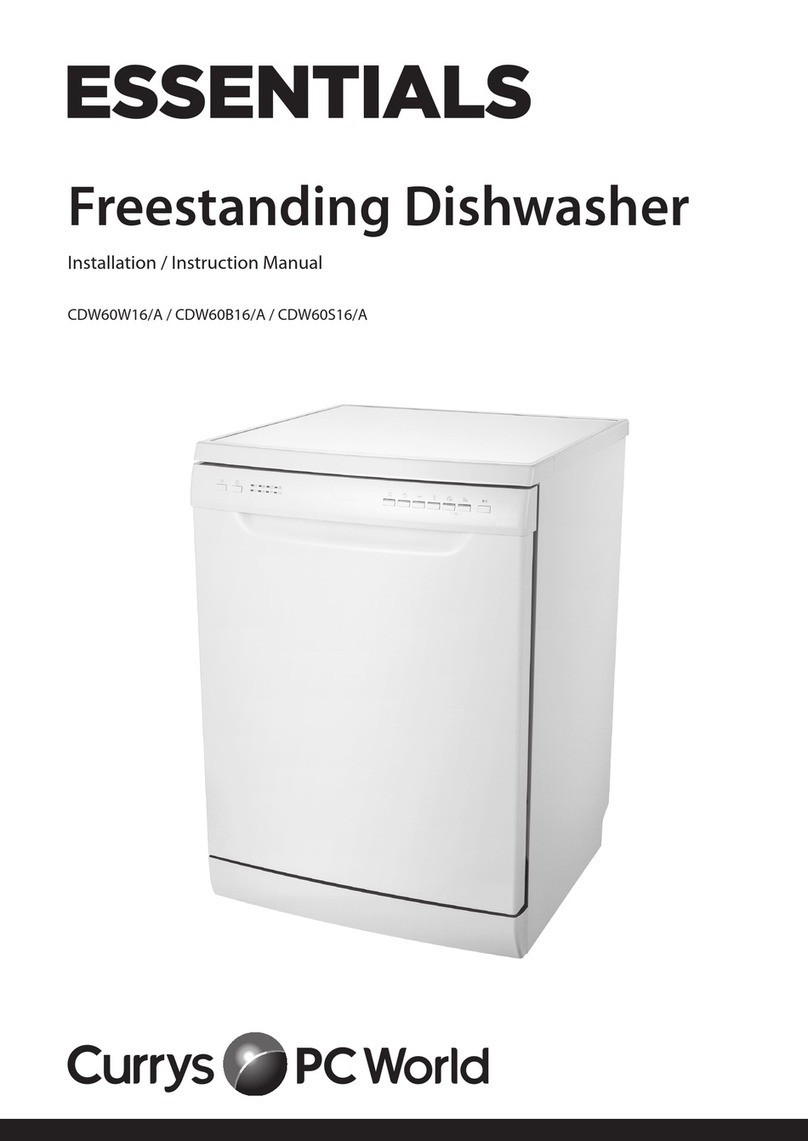
Currys
Currys ESSENTIALS CDW60W16/A instruction manual

Noble
Noble HT-180 HH Installation, operation and service manual

KitchenAid
KitchenAid KUDS50FVSS - Fully Integrated Dishwasher Door and panel parts
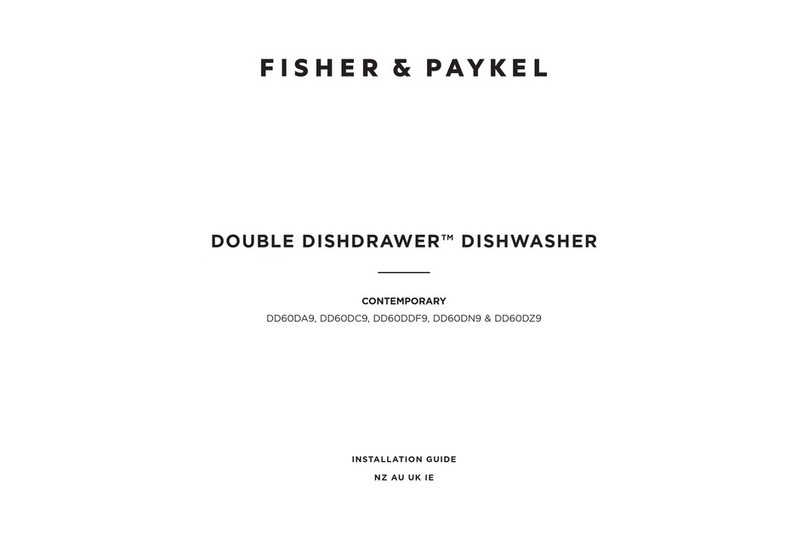
Fisher & Paykel
Fisher & Paykel DD60DA9 installation guide
